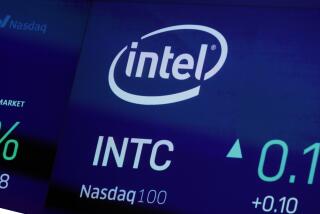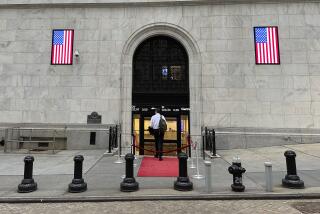1989 Outlook : Chip Makers Face Dimmer Prospects
- Share via
The chip market is hardly for the faint of heart.
After soaring to record heights last year, semiconductor sales growth in the United States is widely expected to come to a screeching halt this year. And that’s the best that could happen, say the analysts.
The “worst case” outlook contains the specter of widespread price-cutting, a sales decline and mounting stockpiles of unsold electronic components.
Although few people foresee disaster for the entire industry, some companies--notably Advanced Micro Devices of Sunnyvale, Calif., and National Semiconductor in Santa Clara, Calif.--are already feeling a deep pinch. National, which lost $55.7 million in the six months ended Nov. 27, announced plans Monday to lay off 2,000 workers. Last Friday, AMD, which said previously that it will lay off 2,400 workers, reported a loss of $34.1 million in the final quarter of 1988.
Will the pinch be felt elsewhere? Yes, say analysts, but probably not as strongly as at National and AMD.
“It all boils down to the ‘haves and the have-nots.’ ” said Erik Jansen of Robertson Colman & Stephens, a San Francisco brokerage specializing in high technology. “Companies that have unique products that give the customer extra value will shine in the coming tight year. Companies who don’t have these products and who must compete on price with everyone else are going to suffer. It’s as simple as that.”
However, little else may be as simple in the chip industry. Chips come in a variety of shapes, sizes and functions. The most basic types include logic chips, which help computers process information; memory chips, which store information, and microprocessors, the “brains” that perform the computational work. Products range widely within each category and are constantly changing as technology advances. With each advance, the value of older products drops.
For chip companies, the goal is not just making semiconductors that offer state-of-the-art performance. The real trick is to capture the market by having such products long before the bulk of the competition. “These are the strong companies,” Jansen said.
But Jansen noted that if the market continues to erode, almost any semiconductor maker could suffer. Among the nation’s top three chip makers--Motorola, Intel and Texas Instruments--Jansen said Texas Instruments could be the most vulnerable because its product line has fewer special-feature products than the other two.
AMD and National are considered particularly vulnerable because they rely relatively heavily on sales of logic chips, tiny pieces of silicon used in virtually every kind of electronics product to help process data. Neither company, say the analysts, makes a unique product such as Intel’s wildly popular 386 microprocessor.
The logic chips offered by both companies provide a good example of their problem, the analysts say. These chips represent older technologies and are widely available from a variety of companies. As orders from personal computer makers for these chips have slowed, the producers have been forced to compete on price, eroding their profit margins.
Particularly Vulnerable
“These companies are particularly sensitive to any downturn in the personal computer business,” explained John Girton, an analyst with Van Kasper & Co. in San Francisco.
Or as AMD Chairman W. Jerry Sanders III has said: “When the PC market hiccups, we’re the first guys to get hit.”
The downturn arrived quickly.
Last year, worldwide semiconductor sales reached a record $43.6 billion, up more than 34% from 1987, according to In-Stat, a semiconductor market research company in Phoenix. For 1989, the company is forecasting sales of $43.7 billion, up just 0.2%.
One reason for the flattening, analysts say, is a drop in the sales growth rate for personal computers, an industry that boomed over the past two years. As PC sales began slowing in late 1988, chip orders were curtailed.
But Jack Beedle, In-Stat’s president, said another major cause of the flat revenue expected for this year is price-cutting rather than a decline in the actual number of chips sold. In fact, Beedle predicts that 119 billion chips will be sold this year, up 4.4% from last year.
The price drops have had the biggest impact on companies making products that have lots of competition, such as AMD and National, which compete against dozens of low-cost manufacturers in the Far East.
Price-Cutting Concerns
“This is a cyclical industry,” said Jansen of Robertson, Colman & Stephens. “Profits drop as growth moderates.”
Beedle said he is particularly concerned about the effect price-cutting will have on the industry. He said supplies of dynamic random access memory chips, which were very tight throughout 1988, are now catching up to demand, and prices, once sky high due to the shortage, have eased considerably.
Although that’s good news for computer and electronics equipment makers and consumers, chip manufacturers worry that the price declines will spread to other chips as well. “They have to keep the DRAM prices from having a domino effect on the rest of their prices,” Beedle said of the chip makers.






